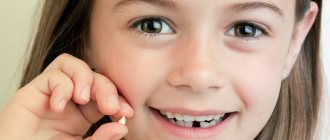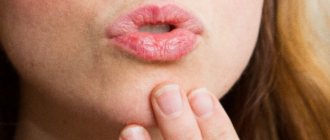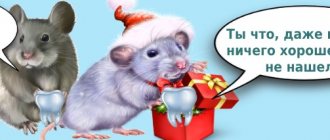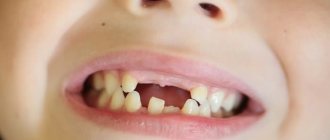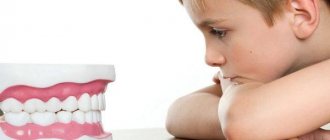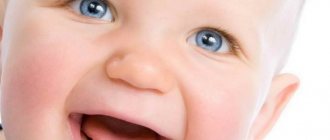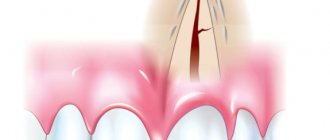Despite the widespread use of digital technologies, in the modern world there is still a place for folk signs, customs, and superstitions. A special place among them is occupied by stories related to children's milk teeth. For example, when the first incisor appears, it was customary for many nations to give a child a silver spoon and be sure to tap it on the emerging tooth. This meant that the baby was ready to meet adult food. Moreover, it was necessary to feed him with this silver spoon. Many signs are associated with their loss.
We’ll tell you where to put baby teeth and whether they can be stored in our article. We will definitely dwell on the interesting signs and traditions of the peoples of the world that have survived to this day.
When does baby teeth change?
The moment when a baby’s lower incisors, as a rule, begin to loosen, can safely be called one of the most exciting in the lives of both children and their parents. Typically, a child's first tooth falls out at the age of 6-7 years. This time for most children coincides with the beginning of school life. This is where the first sign came from: the first tooth fell out, which means it’s time to go to school.
Do not worry too much if the change from milk units to permanent ones does not occur within the generally accepted time frame. They may vary depending on the individual characteristics of the child, the development of his jaw, and the condition of the oral cavity. In this regard, some children begin to lose teeth at the age of five, while others after seven.
Most often, the loss of milk units is preceded by the growth of “sixes”. First, the lower incisors begin to loosen, then the upper ones. That is, their change occurs in the same sequence as growth. So parents have enough time to figure out where to put their baby teeth.
A sign if an adult has a baby tooth
The loss of baby teeth in adults always predicts trouble.
Contrary to the ridicule of ignorant people, baby teeth in adults are not at all uncommon. They can persist for a long time. In some cases - all your life. The anomalous phenomenon is explained by the absence of the rudiments of permanent incisors. This can also happen when they are too deep from the roots of milky specimens. In this case, the incisors cannot push them out and remain inside the gums.
Inadequate development of permanent teeth can be caused by:
- hormonal imbalances;
- hereditary factor;
- disruption of the endocrine glands;
- osteomyelitis of the jaw;
- periodontitis.
It is not at all necessary to part with dairy specimens. If they do not cause concern, there is no need to remove them; they can last for decades.
The loss of baby teeth in an adult always indicates the presence of health problems. Dentists confirm this by recommending an examination of the body.
Superstitions on this score also have exclusively negative interpretations. Among them:
- exposure to other people's negative energy;
- weakening of the aura or a hole in it;
- betrayal of family and friends;
- betrayal, divorce.
Due to the negative consequences, fallen teeth of an adult should not be stored. They are buried or burned, destroying the negative.
Parents' actions when changing primary incisors
Dentists assure that a child whose first teeth are becoming loose does not need pain relief for this process. Although some parents think differently. In fact, before a tooth begins to loosen, its roots dissolve. But discomfort and pain can be caused by a wound formed at the site of a fallen tooth.
Parents of a child whose first tooth has just fallen out can help by:
- Explain that the process of loss is another stage of growing up. Now the child has become very big and can be proud of it.
- Take care of your oral hygiene by rinsing your mouth with a soda solution.
- Warn the child that the wound formed at the site of a lost tooth should not be touched with hands, so as not to cause an infection.
- After eating, suggest rinsing your mouth with warm water. Do this until the wound heals.
Signs about wisdom teeth
Wisdom teeth erupt later than others - by the age of 18–20. It happens that they don’t come out at all, and people live without them their whole lives. According to signs, the absence of wisdom teeth indicates that a person is deprived of contact with his ancestors. Only those who have a complete set of four eights are under the protection of the clan.
The Slavs believed that only those people who are under the protection of heavenly powers have 4 wisdom teeth. For this reason, they were not recommended to be removed even in case of acute toothache; they were “talked about.” If teeth did fall out, they were kept in the house or buried in a cemetery. According to gypsy beliefs, this promised untold riches.
Most superstitions about teeth these days seem naive and meaningless. However, the beautiful rituals of giving a spoon for the first tooth and telling your child stories about the mouse and the tooth fairy should not fall into oblivion. It is important to accustom a child to proper oral hygiene from childhood, and then he will not be afraid of any superstitions.
Do I need to see a doctor?
Ideally, when baby teeth are replaced, they fall out on their own, meaning no removal is required. But in 80% of cases everything turns out a little differently. The permanent tooth begins to emerge after the milk tooth, when it has not yet fallen out. And since he encounters an obstacle on his way, he changes his direction in the wrong direction. Subsequently, this leads to the formation of an incorrect bite in the baby.
To help the baby tooth leave its place faster and free up the permanent one, you need to consult a doctor. Only a competent specialist can surgically remove a unit of dentition correctly. If you try to do this yourself at home, you can damage the gum mucosa and provoke the development of an inflammatory process. You may also need the help of a dentist in the following atypical situations:
- with swelling and severe pain in the gums;
- with bleeding and long wound healing;
- when a tooth is broken or severely damaged;
- in case of ingestion of a unit of the series.
As soon as a child’s tooth begins to loosen, he is most often in high spirits. Very soon the child will be able to show off to his friends how grown up he has become. At this very moment, parents are overcome by another problem, namely, where to put their baby teeth. You should think about this in advance.
Deviations in timing and problems when changing teeth
Every tenth child encounters difficulties in changing teeth. Modern medicine knows many ways to combat the most common abnormalities:
- "Shark's Mouth"
This term refers to the situation when the baby teeth have not yet fallen out, but the molars have already begun to grow in the second row. In this case, you need to immediately go to the dentist as soon as possible so that he can remove unnecessary units.
- Changing teeth too early or too late
If a child's teeth begin to fall out before 5 years or after 8 years, this is considered a deviation. Possible causes include tooth decay, heredity, hormonal problems, jaw injuries and serious illnesses (leukemia, diabetes, etc.).
- Lack of new, permanent teeth
If a tooth has fallen out a long time ago, and a new one does not appear, this is a reason to visit a doctor. The dentist will take an x-ray and see if there is a tooth germ. In its absence, a diagnosis of adentia is made. The problem is quite rare and requires contacting a prosthetist.
Where to put a lost baby tooth?
As you know, in most children the lower primary incisors are the first to leave the dentition. And even if this event did not happen at home, but in a dental clinic, the doctor is obliged to give the child his tooth. And already at home, mom and dad will decide for themselves what to do with the child’s fallen baby teeth. But most parents don’t dare throw it in the trash.
Many mothers carefully store objects that remind them of the first years of their baby's life. These include an ultrasound picture taken during pregnancy, a tag from the maternity hospital, and the first curl cut at 1 year. It is along with these things that most mothers prefer to store the first tooth that falls out.
If parents are superstitious enough, they can conduct a real ritual of farewell to the milk element with their child, which he will remember for the rest of his life and will be able to pass on this tradition to his children. To do this, you should get acquainted with the signs of different peoples of the world in advance.
A tooth is broken - what's the point?
In signs about lost and broken teeth, not only their damage is taken into account, but also the features of the event:
- It matters how the tooth was lost by an adult: during a meal, in a fight, or other circumstances;
- the nature and strength of pain and blood loss are taken into account;
- it is important which tooth is damaged (loss of wisdom teeth was considered the most dangerous).
According to the signs, if a tooth breaks, this promises a person the following dangers:
- says that there are many envious people around, so none of the people can be trusted;
- tooth loss with blood warns of the loss of a relative or friend;
- predicts the approach of a long illness;
- promises separation from a loved one, betrayal of a significant other;
- loss of a tooth by one of the spouses shortly after the wedding is a warning about a barren marriage or frequent quarrels during their life together;
- a chipped baby tooth is a sign that the child will have problems with friends, which will require parental intervention.
When a tooth breaks off and the damage is minor, signs predict the following imminent events:
- if a person resolves complex issues at this time, goes to court, argues with opponents, the situation will not be resolved in his favor;
- when a piece of a molar breaks off, you should soon prepare for the loss of some of your material wealth;
- a hole in a tooth speaks of causing damage, envious people around a person.
Is it possible to store baby teeth?
Until recently, it was believed that elements of the dentition that had fallen out independently or surgically removed should be immediately disposed of. Black magicians, witches and sorcerers could steal them from home and plot or damage them. That's why parents didn't stand on ceremony about where to put their baby teeth. They were thrown away or buried deep in the ground.
Today, the opinion about methods of disposal of fallen baby teeth has changed dramatically. The fact is that British scientists have learned to extract stem cells from pulp. It has been proven that their potential is much stronger than biomaterial taken from the umbilical cord of a newborn. To find out more about this, parents can contact a stem cell storage bank. Biomaterial is stored in this medical institution at a temperature of -196 °C. Frozen cells can later be used in the treatment of serious diseases, including bone marrow transplantation.
Mouse
A few centuries ago, it was believed that storing such things was a bad omen. People believed that witches and sorcerers could secretly steal children's teeth for all sorts of conspiracies and rituals. Nomadic peoples, for example, buried children's teeth, believing that this would not only protect the child from damage, but would also bring him happiness in later life. Today, the view on this issue has changed dramatically.
Lost baby teeth are a real treasure trove of stem cells. Instead of throwing away such treasures or storing them aimlessly in a box, they can be donated to a stem cell bank. What are they needed for? Everything is very simple! The fact is that the potential of such stem cells, which are much more powerful than cells taken from the umbilical cord, is several times higher. They can be used for a variety of conditions, ranging from retinal problems to complex fractures.
We suggest you familiarize yourself with Caries on the front teeth and its treatment
Thus, storing baby teeth can be of great benefit. If you have this opportunity, why not take it? Despite the fact that the technology for collecting stem cells in this way is quite young, a great future is predicted for it.
Tooth Fairy
Our grandmothers also taught us, when throwing out a milk tooth, to say: “Mouse, mouse, take away the milk tooth, and bring me a new one, bone and durable.” It is very difficult to say now what this sign is connected with. It is believed that the incisors of rodents are very strong, which is why, by giving the loss to a mouse, the baby expects that he will grow the same strong teeth.
In addition, it was the mouse that was addressed, since small rodents were frequent guests in the villages. They lived behind the stoves and under the floorboards. That is why in the village they threw the tooth into the stove or into the cellar so that the mouse could find the treasured gift for sure. It is interesting that the tradition of giving a mouse as a gift existed not only in Russia, but also abroad.
Changing teeth is undoubtedly a significant and exciting event in the life of the whole family, indicating that your child is becoming an adult. At the same time, you should not suffer from superstitions and signs. Do what you see fit in this situation.
Even those parents who decide to maintain the fairy-tale illusion do not always know what to do next with the “trophy”. Should I get rid of it and how, or should I keep it as a keepsake? Here everything depends only on your desire. After all, in fact, the process of changing teeth is associated with the natural maturation and maturation of the body.
And yet, according to existing beliefs in different countries, it is not recommended to throw away milk units. It is believed that in this case the child will have bad teeth, or he will suffer from insomnia, or even be doomed to live far from his homeland.
It's hard to say whether this is true or fiction. But if you do not want to keep such a childhood memory, then it is best to use the most popular recommendations:
- bury the tooth in the ground in the yard or even in a flower pot;
- burn in fire.
In some countries, it is believed that the top units, after falling out, are best thrown onto the roof of the house. And if the lower ones are lost, then they are buried under the porch.
If the fairy tale is more typical for foreign countries and a similar tradition can often be seen in family films, then in Russia the version about the mouse is more common.
According to some sources, the story with the mouse was transformed from a belief that said whichever animal it takes, the teeth of that animal will be similar to the new ones.
It is no secret that rodents have strong and small neat teeth, so it was proposed to give them to the mouse and not to other animals. In some versions of the mouse sign, the child is recommended to throw it over his right shoulder.
Many parents teach their children to accompany a gift to a mouse with the words: “Mouse, mouse, take a rotten tooth for yourself, and give me a root one.” “Mouse, mouse, take the milk tooth and bring me the bone tooth.”
To make the fairy tale even more enjoyable, after the exchange, you can throw some sweets or other pleasant little things to the baby and tell him that this is the mouse’s gratitude.
In fact, there is nothing wrong with throwing it away, and sometimes a loose baby tooth can fly out completely unnoticed by a child during sports or simple pampering.
Of course, parents’ neglect of their baby’s teeth will not go unnoticed and will certainly leave an unpleasant aftertaste, so it’s better to come up with some kind of story or use existing ones.
In ancient times, in many countries it was considered a bad omen to throw away a tooth and not set it on fire or give it to some fairy-tale character. It was believed that a person who simply threw it away might begin to suffer from insomnia, and in addition, his new teeth would look like a wolf’s.
Another sign is that a person who has not burned his molars will live far from his homeland. The last sign came from England and sometimes they still remember it there.
Between the ages of 6 and 13 years, children's primary dentition gradually changes. Many of them have a hard time losing a tooth. It is important to explain to the baby that a new tooth will soon appear from scratch, and it will need to be looked after very carefully.
What to do with lost teeth? Throwing it in the trash is wrong. You should perform a small ritual that will please the child and help him believe in miracles.
In Western culture, a tooth that falls out is given to the tooth fairy, who brings back a coin in return. In Rus', a mouse or a kind brownie takes a tooth. In exchange, they don’t give money, but strong and healthy permanent teeth. You can perform a small ritual: throw a tooth over your shoulder towards the new moon and make a wish. Then offer your baby yogurt or mouse curd that is good for teeth. It will be better than any treat for a child!
What should parents do with their lost teeth? They can be buried in a secluded place or burned. A modern way to get rid of baby teeth is to donate them to a stem cell bank. There are many such cells in baby teeth, and they can serve for the benefit of people. The technology for collecting stem cells from teeth is quite young and promising. The cells themselves help fight a variety of diseases, ranging from vision problems to complex fractures.
What to do with a child’s baby teeth: folk signs
From time immemorial, each nation has had its own traditions and customs regarding the storage of fallen child teeth. For example, nomadic tribes always buried them. Therefore, there were no questions about what to do with the child’s baby teeth. The parents had to dig a deep hole, put the tooth in it and cover it with earth. It was believed that this was the only way to protect the baby from damage and misfortune.
The peoples of Britain had their own traditions regarding where to place a child's baby teeth. Folk customs boiled down to preventing damage to a child using a tooth. For this purpose, any milk element of the row was burned immediately after falling out. It was believed that in this case a strong and healthy one would quickly grow in its place.
Another sign common among the British in ancient times is associated with animals. It was believed that the tooth should be destroyed, hidden or buried so that a predator would not get it and eat it. If this happens, the child will grow fangs, like an animal.
Today all these signs seem strange and funny, but our ancestors sincerely believed in them and, worried about the fate of their children, unquestioningly carried out all these actions.
Signs when the first tooth appears
There are several different signs among people that refer to the appearance of a child’s first incisors. The usual period in which they begin to grow in babies is the age of 5–6 months.
If the tooth erupted earlier or later, this was a reason to judge the possible future of the child. We paid attention not only to the time of appearance, but also to the sequence of filling the dentition and the structural features of the jaw:
- If the first tooth comes out beyond y - the birth of a brother or sister a year after the baby was born.
- If teeth appeared with a delay relative to the traditional period (later than 7 months), the child was predicted to have talent and great achievements in a certain area.
- If a coin, turned edgewise, was placed between the baby’s two central upper teeth , the parents believed that their child would be successful with the opposite sex. The second interpretation is luck in adult life.
- The baby was born “toothy” or he first developed fangs - a bad sign, foreshadowing imminent death or service to evil in adulthood. But there is also the opposite interpretation - in adulthood a person will be very successful and lucky.
These superstitions can hardly be called relevant, because dentists have long proven that the speed of tooth formation and the structure of the jaw is determined by the innate characteristics of each child, and not by mystical reasons.
There is a belief that will help young mothers determine the moment when they can start complementary feeding.
The sign says that when the first tooth comes out, the baby should be given a spoon made of silver, and be sure to knock on the tooth with it. This action symbolized that the baby could already eat something other than his mother’s milk.
Why give a tooth to a mouse?
Among the Slavic peoples, one of the signs of where to put a baby tooth was associated with throwing the fallen unit behind the stove. This was done for a brownie or a mouse. They had to take the baby tooth and bring the molar tooth in return.
In some European countries, they also adhere to the custom of placing the tooth under the pillow at night. But it’s not the kind tooth fairy with wings and a magic wand in her hands who should take it, but a little mouse. In France she is called La Petite Souris, and in Spain - Perez. Traditionally, at night, an unnoticed little mouse sneaks under the pillow to exchange a tooth for money or treats. Children eagerly await the appearance of this rodent in order to receive something nice as a gift.
Where do signs, beliefs, customs come from?
Each country has its own signs and superstitions associated with the main event in a child’s life. Sometimes, the customs of peoples are radically different from each other. If your baby has such an important event, you have the right to act in accordance with any traditions.
American traditions
In America there is a belief about a mysterious fairy who flies at night and takes away baby teeth. To do this, they are placed under the pillow, in the hope of finding a long-awaited coin in return. Perhaps this tradition can be considered one of the most famous and widespread.
English traditions
More complex traditions developed among the northern English. There it was believed that a lost tooth must be burned. Firstly, this eliminated the possibility of using it for the purpose of inducing witchcraft and damage, and secondly, they believed that a stronger and healthier one would take the place of the burnt tooth.
Another equally interesting English tradition associated with these things states that a baby tooth must be destroyed in any way so that no animal can swallow it. If this happens, the child will have an ugly smile, or the exact same fangs as those of the animal that swallowed him.
The Slavs had several interesting signs. Most often, the loss was given to the mouse, which was supposed to take it for itself and bring a new one in its place. They also threw their teeth behind the stove and asked the brownie to take them for themselves.
Gypsy traditions
If a child lost a tooth, they either buried it, reciting special spells, or threw it to the moon. It was believed that in this way one could attract good luck, which would accompany the child throughout his life, protecting him from ill-wishers and various troubles.
In Asian countries, there was a funny belief that a new one would grow in place of a lost tooth. At the same time, the fallen upper teeth were thrown onto the roof of the house where the baby lives, the lower ones were hidden under the porch, and the parents repeated a special spell that was supposed to provide the baby with protection from the evil eye.
Folk beliefs and customs arose in the distant past, even when our ancestors were pagans. People knew little about the world around them and were defenseless against the rampant elements. With the help of signs, they tried to protect their family from many things for which they could not find an explanation. We always analyzed what was happening around us, looked for patterns, remembered which events lead to joy and which ones promise failure.
This is how signs arose. Customs and rituals appeared that were supposed to appease the representatives of the other world - good and evil spirits, and help a person survive.
Centuries later, many people also believe in signs of fate and listen to everything that concerns the health of loved ones. Beliefs associated with teeth occupy a special place, because for a long time teeth have been a symbol of strength and strength.
Who is the tooth fairy?
In many countries of Northern Europe, America and Canada, they adhere to a different sign about a child’s baby teeth. People here know where to put the dropped element of a row almost from birth. Kids eagerly wait until their tooth begins to loosen so that after it falls out, they can put it under their pillow. In return, the good fairy should bring a coin there. This tradition is one of the most widespread and popular today. By the way, the fairy tale about the tooth fairy and the mouse Perez was invented by the Spanish writer Luis Coloma for the eight-year-old King Alfonso VIII, who lost his first baby tooth.
The myth of the good sorceress is a useful one. It helps the child overcome the fear of a lost tooth and allows him to receive monetary or other pleasant compensation for the loss.
"Dental" rituals
Even ancient parents thought about where to put a child’s baby tooth. Here are the solutions they found:
- Tooth Fairy. In many European countries and America, a “magical” solution to the problem with the help of “tooth fairies” has long been common. The parents put the fallen tooth under the pillow at night, and the next morning they take out a coin or a gift from the fairy. Children usually like this game.
- Burning a tooth. In England, superstitious parents in the past burned their children's lost teeth, fearing that someone would use them for witchcraft purposes. In addition, in their opinion, this protected the babies from the appearance of fangs in the place of the old incisors.
- Gift for a mouse. This funny and strange custom originated in Rus' and is still practiced in many families. The child clamps the “burdock” tooth in his fist, and then asks the mouse to replace it with a “bone” one and throws it behind his back.
- Tribute to the spirits. In addition to mice in Rus', milk teeth were picked up by perfume or brownies. The children made the same request to them as they did to the mouse, hoping that this would make their jaws stronger.
Today, to calm their children, parents most often resort to a fairy tale with a fairy or a mouse. However, children cope well with the loss of an incisor even without these fantastic stories. Often it is enough just to explain that what is happening to them is a normal part of the process of growing up and that soon strong adult teeth will appear in their mouth instead of temporary ones. Children always want to grow up quickly, so this explanation will calm them down.
Additional Information. Children's milk teeth are often unreasonably given great importance, believing that they are endowed with some kind of charm. So, some wives sew them into their husbands’ clothes so that they do not leave the family. Others wear them around their neck or in their pocket as a talisman. All this is nothing more than superstitions from the past.
Do you need a gift?
Regardless of where the mother decides to put her child’s baby teeth, where to put them or to throw them away altogether, it will be very good if she prepares some surprise for the baby. This will make it easier for him to bear the loss.
If a child puts a tooth under his pillow, the first thing he will do when he wakes up is check to see if the mouse or tooth fairy took his treasure. If yes, then a coin or present should appear in this place. This could be a book, a coloring book, a set of pencils, paints or markers. Parents should choose gifts that can easily fit under the pillow. If the gift is too large, then it will have to be placed next to it.
It is not recommended to give chocolate, sweets and other sweets. The tooth fairy cares about the health of children's teeth, so she should give them only useful gifts. And as you know, sweets quickly begin to deteriorate your teeth. It is better to put a coin under the pillow, and for it the child will buy what he likes.
Traditions of the peoples of Asia
In many Middle Eastern countries, children do not leave their lost tooth to a mouse or fairy. Instead, they throw it up towards the sun. It is believed that this will allow teeth to grow faster and stronger than before.
A similar sign of where to put a lost baby tooth is followed in Japan. To get a new one instead of the old one, you need to make a good straight throw. But the bottom tooth should be thrown up, and the top one down, that is, in the opposite direction.
Tooth on the roof
Throwing up fallen milk elements is a fairly common sign among many nations. But children in some countries strive precisely to throw a tooth onto the roof. This is done in Greece, Brazil, Ethiopia, and Sri Lanka. But in China, Korea, Vietnam and India, this is done only with the lower teeth, and the upper ones, on the contrary, are thrown under the bed or even hidden in cracks in the floor. And every baby knows where to put baby teeth.
You need to throw your teeth onto the roof so that a bird or squirrel can grab it faster. Then a new one will very quickly grow in its place. And a tooth under the bed, most likely, can easily be dragged away by a mouse.
Maybe the tooth needs to be hidden?
Not everyone wants to give their lost treasures to an animal or some fairy-tale creature. In Nepal it is considered very bad luck if a bird takes a tooth and does something with it. In this country, children come up with their own secret storage places that even adults don’t know about.
In Malaysia, fallen milk teeth are also hidden, but only in the ground. The kids bury them, thus returning them back to nature.
In Turkey, parents believe that with the help of baby teeth they can influence their child’s choice of future profession. So, they bury the fallen elements near the hospital if they want their child to be a doctor, or near the school if they dream of seeing him as a teacher. Football fields are especially popular.
